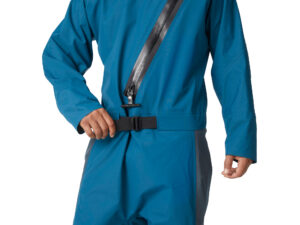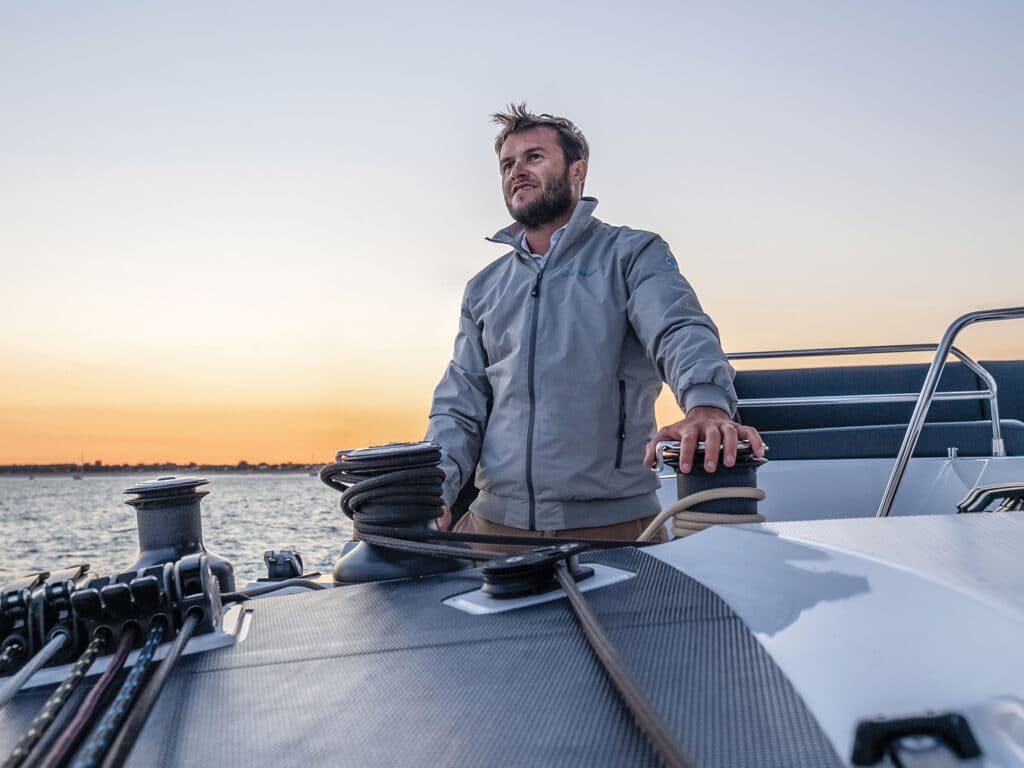
Thanks to modern advances in boatbuilding, onboard systems and technology, the sport of cruising is poised for some exciting times ahead.
Read More: The Days of Dishy McFlatface Have Arrived | Generators Not Included
When Drew Lyman says his new Lyman-Morse 46 is “a cruising boat that can sail really freaking fast,” believe him.
That was a quick mental note I took during Boat of the Year sea trials as we popped up the sail kit and shot off faster than a spooked buck in hunting season. The LM46 proved to be a showstopper on multiple levels while earning Cruising World’s 2023 Domestic Boat of the Year award.
“Cold-molded construction, top-notch systems, a powerful sail plan, and an interior that is practical and lovely at once; wow!” judge Mark Pillsbury commented. High praise in modern times, and, for the venerable Maine shipyard that decades ago gave us the classic Seguin line, a revelation of just how far we’ve come in the modern world of boatbuilding.
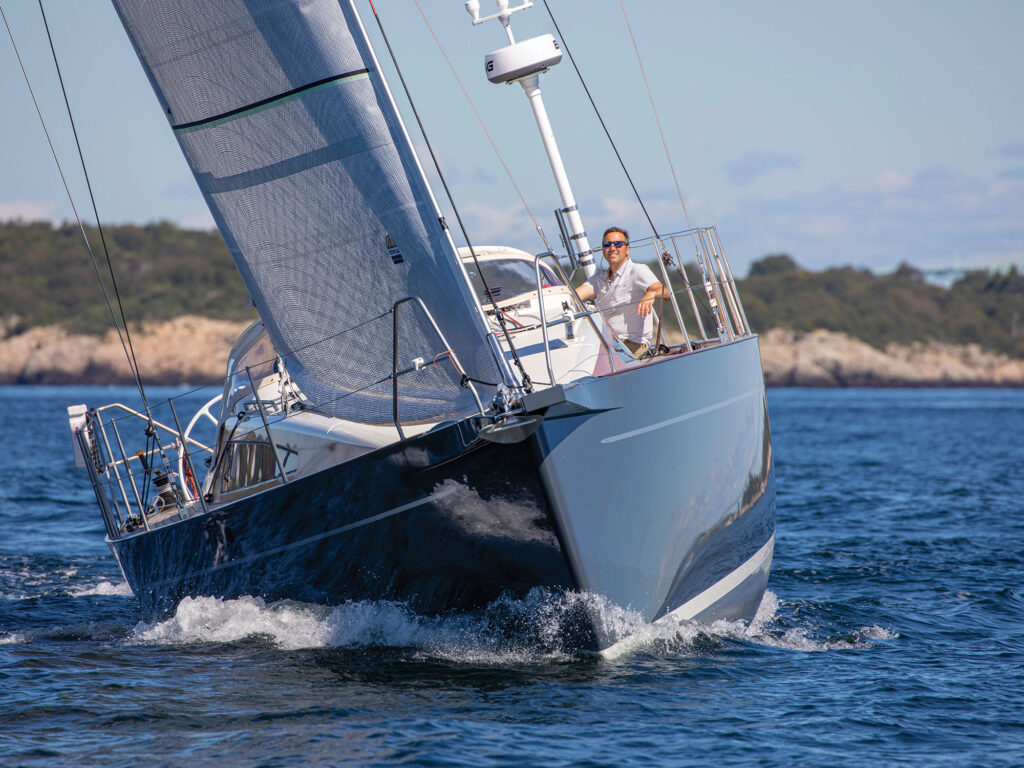
The 2023 Boat of the Year contest was hardly a runaway. This year’s field was among the most competitive in years. Innovation was thick in the air, which happened to be blowing between 15 and 25 knots out of the north, superb conditions for putting 17 thoroughbreds through their paces. Over the course of four days that featured some spectacular sailing, it became obvious that a number of technological advances are making boats faster, safer and more comfortable in all kinds of winds.
PERFORMANCE INNOVATION
When we talk about performance innovation in boatbuilding, we’re generally talking about evolutionary changes to existing building processes, designs and tooling. These are made better by one (or several) contributing developments that are trickling down from the racing sector into mainstream sailing.
Proof of that lies in the America’s Cup foiling effect, which informed the fierce-looking 40-foot G4 from carbon cruising cat specialist Gunboat a few years ago. True, most ordinary sailors have little desire to sail at speeds over 20 knots, but it’s hard to ignore a production boat that employs that technology.
“With what the America’s Cup boats are doing, the innovation is pretty easy to catch,” says Lyman, whose company is also now playing in the foiling arena with its Navier line of electric foiling powerboats. “What has me and all of us at Lyman-Morse excited about the partnership with Navier is that we are developing something that is cutting-edge and certain to be the future of yachting in this type of market. To build a carbon-fiber, foiling all-electric boat fits well with what we do at Lyman-Morse, plus it’s a boatbuilder’s dream project. We built a reputation for beautifully crafted boats, and we are extremely proud of our ability to implement advanced systems and technology.”
The question for Cruising World readers is: When might we see foiling come into monohulls?
“It might not be for the faint of heart, but I think it’s only a matter of time,” Lyman says. “I do think at some point that a lot of these boats are going be using foil-assist in the future, at least to some capacity.”
In terms of construction, Lyman considers computer numerical control and 3D printing to be game-changers when building in sustainable wood. The yard’s Haas GR-712 CNC machine is used to cut planks, bulkheads and joinery, reducing the cost for hull and deck construction. All items for the LM46 were built as modular units outside the boat using a combination of time-tested processes and high-tech tools such as lasers and 3D printers. The result is an LM46 that stands out amid a world of fiberglass boats.
“We’re looking for that time when parts can be 3D-printed,” Lyman says. “You can do it now, it’s just very expensive, and they’re smaller parts to get the resolution and quality you want, but we’re getting closer. We just need some structural components that can be 3D-printed. Boat parts or tools that can be printed in short order for repairs. Can you imagine? That’s the future. It’s fascinating, and it’s coming.”
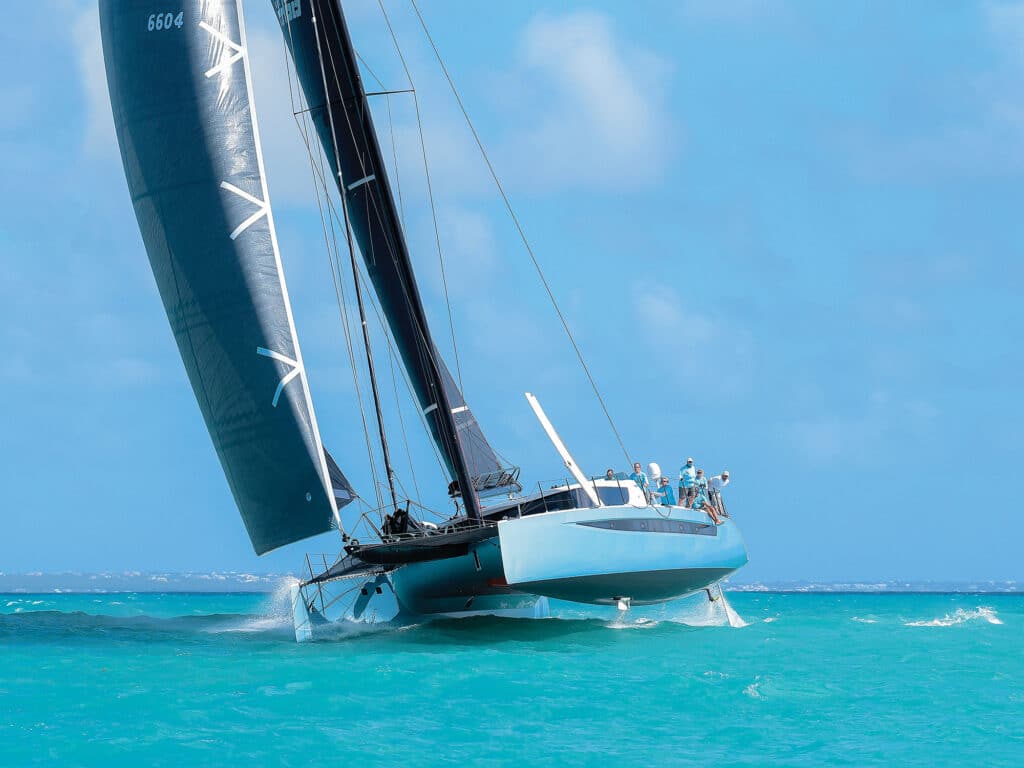
Jeff Johnstone, president of J/Boats, which specializes in high-performance sailboats, agrees that technology can simultaneously improve performance and handling in racing, while providing huge benefits for cruisers. His company’s newest model, the J/45, was the 2023 Boat of the Year’s Best Performance Cruiser.
“Starting with our first cruising design, the J/40, we’ve prioritized stability and seakindliness in all of our cruising designs,” Johnstone says. “This starts with lowering the vertical center of gravity by optimizing hull and deck laminates for maximum strength-to-weight ratio, introducing carbon-fiber spars as a standard option, and new keel designs that concentrate the lead ballast low without adding excess draft. Then we add a moderate-size sail plan (main and small jib) that can sail in as little as 5 knots of wind, and can depower with sail controls to handle 25-plus knots. With the J/45, we took it a step further, by also prioritizing liveaboard comfort and systems.”
Hylas Yachts, whose Swiss Army knife of an H57 won for Best Overall in the 2022 Boat of the Year contest, has a company philosophy that is somewhat of a testing lab in itself.
“We still receive a ton of client feedback and are constantly improving on the H57—things like slightly extending the hardtop, a better-looking spray shield, moving the water heater to a more serviceable location, and more,” says Hylas Chief Operating Officer Peggy Huang.
The team prioritizes the innovation process, employing people who are constantly driven and incentivized to improve the product and how it’s made. According to Huang, this culture of innovation extends to awareness of clients’ needs.
“Some of our best resources are our clients,” Huang says. “It’s very rare that a new-build client hasn’t spent a great deal of time considering the options they might wish to introduce into their dream yacht. We actually have a great network of loyal Hylas cruisers who are constantly sharing ideas and flagging up new developments.
“So often, performance in yachting is measured in knots, windspeeds and polar plots,” Huang continues. “The reality is that durability, longevity, ease of handling, comfort, and efficiency are all part of how a yacht performs relative to the objectives set by the manufacturer and designer. Durability and longevity come from developments in the composites being used in construction. Not only are the materials important, but also how they’re formed. The introduction of vacuum infusion into mainstream yachtbuilding has helped considerably, as has the use of CNC equipment in the forming of component parts.”
Huang also says that the vast majority of Hylas’ suppliers are constantly striving to better meet those needs, directly benefiting the end product.
“Everything from North Sails and their new 3Di technology to the ability to combine advances in lithium batteries with variable-speed air conditioning has really got people’s attention,” Huang says. “Although the wind is our primary source of power, we do have to keep an eye on the new hybrid developments in engines as solar power becomes increasingly efficient. The ability of batteries to hold a charge while reducing in size and weight is enormously important. If it isn’t already standard for other builders, then lithium has to be a consideration. We get a big response at shows when cruisers realize that the combination of battery improvement and air-conditioning efficiency means they can get a good night sleep with the AC running and no need for a generator.”
Naturally, multihulls remain on the front lines of any trickle-down effect from racing technology, and Chris Bailet, sales and commissioning captain at HH Catamarans, likes what he’s seeing in terms of vessel integrity.
“You see things; and you say ‘Why?’ But I dream things that never were; and I say ‘Why not?’”
—George Bernard Shaw
“Take a newish construction material such as carbon fiber—weight savings is everything on a performance catamaran,” Bailet says. “The structure and strength we can integrate into these boats today is incredible. The loads we see on HHs are astronomical, similar to loads on much bigger monohulls. The integrity has to be there.”
So does safety, which, according to Bailet, is always at the forefront. “With the high level of performance involved, we try to keep some training wheels on the owner-operators, such as integrating a mainsheet release system that is connected to the cap shroud loads, based on heel and pitch, and it can also be connected to the main sheet load,” he says.
With so many new technologies and products coming down the pipeline, from batteries and hybrid systems to deck hardware and digital switching, Bailet underscores the challenge of integrating it all.
“I think we’re good on the cutting-edge side of the structures,” Bailet says. “Now it’s a matter of what you can drop in there while keeping the power-to-weight ratio as consistent as possible for a high-performance boat; adding bells and whistles while remaining a performance cruiser, not a clunky tub full of fun stuff. We still want to have those 250-mile days, but also with the air conditioning running and the pizza oven hot. That’s the challenge.”
RESPONSIBLE BOATBUILDING
We tend to equate innovation with performance, sleek design and cutting-edge amenities. But innovation isn’t always about winning the race. For some builders, it’s as much about finding solutions to the world’s problems.
“Maybe more on the constructive than the disruptive side, we’re seeing more focus today on sustainability,” Johnstone says. “We’re looking at advances in fiberglass recycling and end-of-life initiatives, new and innovative composite fiber, matrix resins and core materials that are sustainable, clean options for auxiliary power to replace traditional diesel, and solar technology. Is it conceivable that for every new fiberglass boat built in the future, one gets recycled? Well, yes.”
In an industry that exists on the front lines of climate change, there’s little debate about whether manufacturers should be taking a lead role in employing more environmentally friendly building practices and materials. Two French boatbuilders—Groupe Beneteau and Fountaine Pajot—are driving that initiative with tangible results. Their efforts caught the eyes of our Boat of the Year judges, who awarded special recognition for clean and innovative building practices.
“As boaters, we’re dependent on nature every time we step on a boat,” says Damien Jacob, sailboat product director at Groupe Beneteau. “We have a responsibility to be aware of our impact on the environment. As builders, that starts with being honest with our own processes. The truth is, it’s not a clean industry, but we can improve it.”
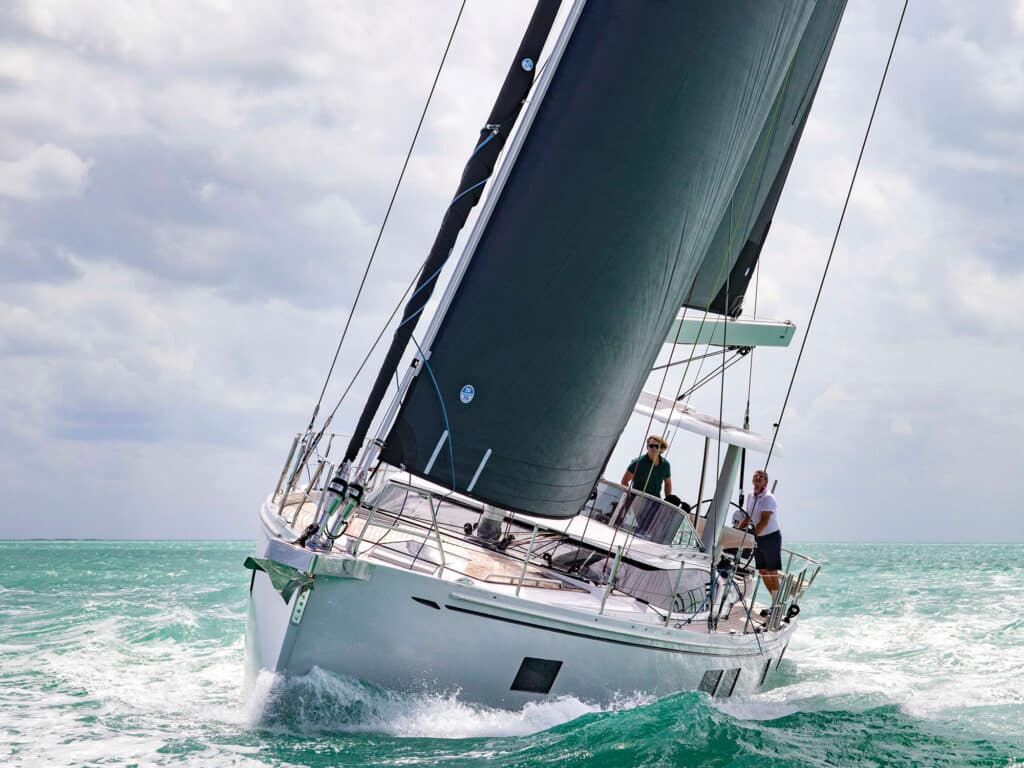
For Groupe Beneteau, that meant looking at product development and manufacturing processes. On the product-development side, the company is reducing environmental impact in two key areas: composite materials and propulsion. The first results were seen at December’s Nautic boat show in Paris with the premieres of the First 44e and the Oceanis 30.1e, which have two different types of electric engines developed in partnership with Torqeedo.
The Oceanis 30.1e uses all-electric propulsion based on a Torqeedo pod that can be recharged dockside or by solar panels.
The First 44e is made entirely from Arkema’s Elium resin, which is recyclable after the separation of the fiberglass from the resin during the dismantling of the boat. The resin can then be reused for new parts, reducing the amount of waste and the need for raw materials. Instead of traditional teak decking, there’s iroko from Forest Stewardship Council-certified forests; iroko is comparable to teak in terms of resistance, grain shade and touch. The builder also favors natural fibers and bio-based resins for nonstructural composite parts. In the long run, the company hopes to spread these innovations through all of its sailing and powerboat lines.
Fountaine Pajot has taken a similar tack, with a corporate goal of zero carbon emissions by 2030.
“We are living through a great cultural change, and the new generation expects much of us at the dawn of this new era,” says Fountaine Pajot Deputy CEO Romain Motteau. “Our owners are also changing their needs and today expect their boat to be more environmentally responsible, while maintaining a high level of comfort. We [know] that 20 percent of our carbon footprint comes from production and 80 percent from the use of the boats.”
According to Motteau, three objectives will help the builder achieve its goal of carbon neutrality: Reduce carbon-dioxide emissions from thermal engines by developing electric propulsion and helping owners understand how they can reduce engine and generator time; reduce the impact of construction materials, particularly wood and glass fiber and resin; and reduce the impact of the builder’s industrial footprint with a more sustainably oriented production system, through significant investments in factories to limit the use of gas and electricity, and to limit and recover waste.
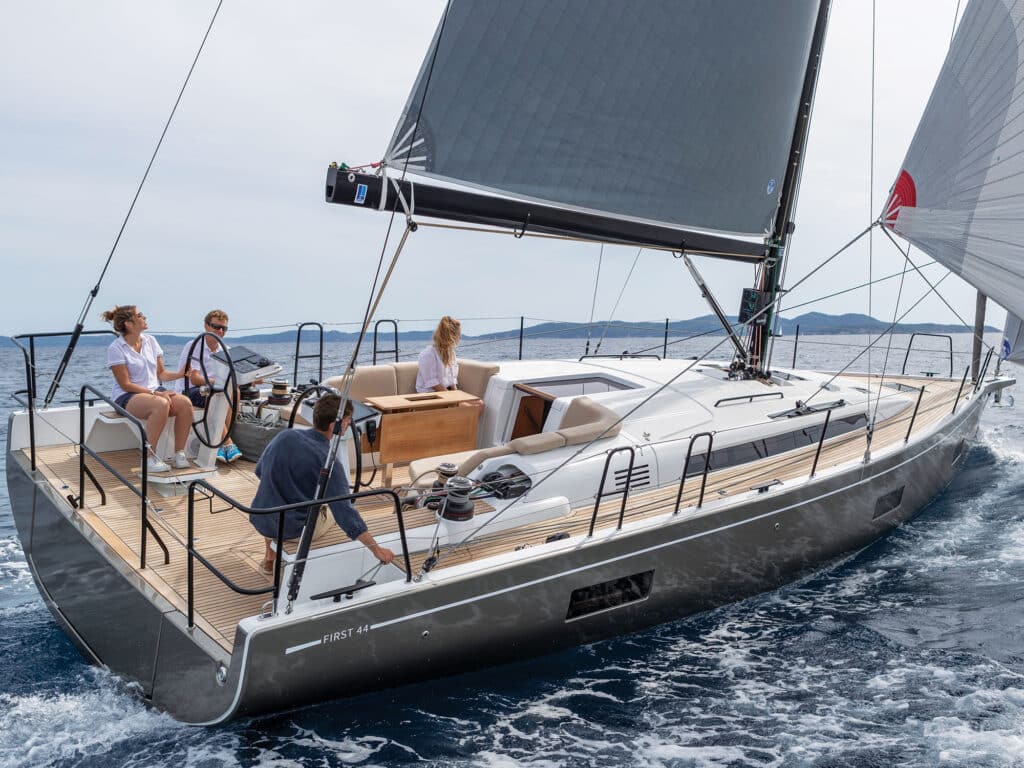
The Aura 51, which debuted at the 2022 Cannes Yachting Festival, is the early result of the company’s Smart Electric initiative to offer a sustainable cruising catamaran, a part of its Odysséa 2024 strategic path toward sustainable boatbuilding.
The technological advances aboard the Aura 51 involve two pods, one under each hull, that propel the boat while their hydrogenerator is producing electricity. The energy is stored in two batteries no larger than those found in a small electric city car. An electronic power-management system and the interface between the various components complete the block.
“It’s offering the possibility of zero carbon emissions while cruising,” says Fountaine Pajot deputy managing director Mathieu Fountaine. “The boat has enough solar production, hydrogen generation and storage to spend a weekend sailing 100 percent electrically, or a week at anchor without using an internal combustion engine. At full electric power, the battery will provide two hours of autonomy, and at reduced power, three to four hours. If the air-conditioning system is used sensibly, it may be unnecessary to start the generator. Ten similar prototypes will be produced next year in the 40- to 50-foot range.”
Paying lip service to sustainability is easy. It’s been done for years. How refreshing to see some builders putting plans in motion. If their current progress is any indicator, perhaps we’ll have a chance to continue enjoying this great life afloat for generations to come.




